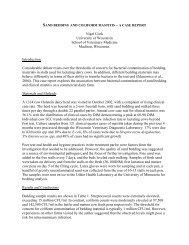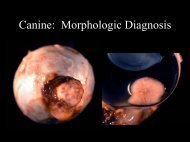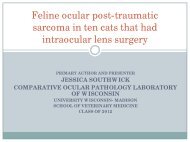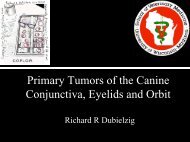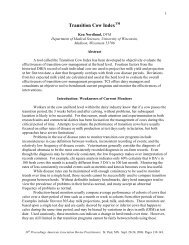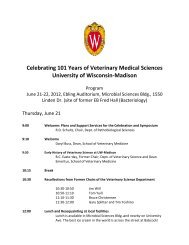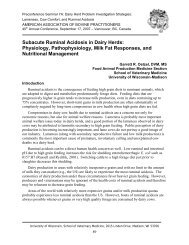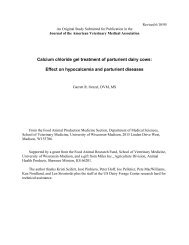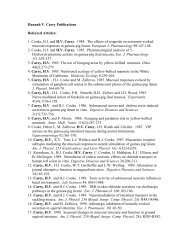A Survey of Ocular Anatomy and Pathology of Vertebrate Species
A Survey of Ocular Anatomy and Pathology of Vertebrate Species
A Survey of Ocular Anatomy and Pathology of Vertebrate Species
Create successful ePaper yourself
Turn your PDF publications into a flip-book with our unique Google optimized e-Paper software.
A <strong>Survey</strong> <strong>of</strong> <strong>Ocular</strong> <strong>Anatomy</strong> <strong>and</strong><br />
<strong>Pathology</strong> <strong>of</strong> <strong>Vertebrate</strong> <strong>Species</strong><br />
Dick Dubielzig
<strong>Vertebrate</strong> Evolution
Hagfish & Lampreys<br />
• No paired pectoral (shoulder) or pelvic (hip)<br />
fins<br />
• Notochord persists for life.<br />
• They have no scales.<br />
• The axons <strong>of</strong> their neurons are unmyelinated.<br />
• Lampreys have both an innate immune<br />
system <strong>and</strong> an adaptive immune system, but<br />
the latter is entirely different from that found<br />
in the jawed vertebrates.
Hagfish Eyes<br />
•No cornea<br />
•No lens<br />
• 2-layered retina<br />
• No melanin<br />
Eye<br />
• Wired to the brain like a pineal gl<strong>and</strong><br />
Recommendation: You-Tube: “Eddie <strong>and</strong> the Hagfish”
Lamprey Eyes<br />
• Larval form <strong>and</strong> adult form<br />
• Cornea largely continuous with the skin<br />
• No muscles <strong>of</strong> accommodation<br />
• Has most <strong>of</strong> the structures <strong>of</strong> the vertebrate eye<br />
–Lens<br />
– 3-layered retina<br />
– Extraocular muscles<br />
– Wired to brain like a visual eye<br />
– Melanin in Choroid <strong>and</strong> RPE<br />
Adult<br />
Larva
Larva Adult<br />
3-layered retina<br />
Cornea continuous with skin
Shark & Ray Eyes<br />
• Cartilaginous sclera, but no bone<br />
• No muscle in the ciliary body<br />
• Smooth muscle attached to the ventral lens<br />
• Double cornea (scleral <strong>and</strong> skin)<br />
• No shading <strong>of</strong> outer segments by the retinal<br />
pigment epithelium (RPE)<br />
“Eye Sucking”
No shading <strong>of</strong> the<br />
photoreceptors<br />
by the RPE<br />
Sharks <strong>and</strong> Rays<br />
Double cornea
Evolution <strong>of</strong> the Fishes
Sturgeon Eyes<br />
• Cartilaginous sclera, no bone<br />
• No muscle in the ciliary body<br />
• The lens is supported on a papilla, but no<br />
accommodation <strong>and</strong> no muscle are known<br />
• Choroidal guanine tapetum lucidum<br />
• Limited shading <strong>of</strong> the outer segments by<br />
the RPE
Juvenile Sturgeon Eye<br />
Papilla<br />
Cartilaginous sclera
Sturgeon Eye Guanine Tapetum
Higher Teleosts<br />
• Cartilage <strong>and</strong> sometimes bone in sclera<br />
• Retractor lentis muscle (smooth muscle)<br />
accommodation<br />
• Vascular rete called “choroidal gl<strong>and</strong>”<br />
• RPE melanin has photomechanical movement<br />
• Some fish have a retinal fovea<br />
• Trichromatic vision<br />
• Double cornea (skin <strong>and</strong> scleral)<br />
• Papillary process supplies blood to the retina
Walls. The <strong>Vertebrate</strong> Eye<br />
<strong>and</strong> its Adaptive Radiation. 1942.<br />
Higher Teleosts<br />
Round lens<br />
Double cornea<br />
Choroidal gl<strong>and</strong>
Retractor lentis<br />
Choroidal gl<strong>and</strong><br />
Higher Teleosts<br />
Annular<br />
ligament
Walls. The <strong>Vertebrate</strong><br />
Eye <strong>and</strong> its Adaptive<br />
Radiation. 1942.<br />
Higher Teleosts<br />
Falciform process &<br />
accommodation<br />
Retractor lentis muscle
Higher Teleosts<br />
Retinal Variations<br />
Photomechanical<br />
Movement<br />
Guanine in the Retinal Tapetum<br />
<strong>of</strong> the Walleye
Degenerate Eyes<br />
Elephant Nose Fish<br />
<strong>and</strong> the Mole<br />
Mole Eye
Diplostomum spathaceum
Teleost Primitive<br />
Neuroectodermal Tumor (PNET)<br />
Fairy Basslet<br />
Thanks to:<br />
Marie Pinkerton
Walls<br />
Amphibian Eyes
Features <strong>of</strong> Amphibian Eyes<br />
• Cartilaginous sclera, but no bone<br />
• Trichromatic vision<br />
• Photomechanical motion in the RPE<br />
• Minimal amount <strong>of</strong> accommodation with smooth<br />
muscle<br />
• Double cornea only in the tadpole<br />
• No annular pad in lens<br />
• Retractor bulbi muscle <strong>and</strong> eyelids
Bull<br />
Frog<br />
Features <strong>of</strong> Amphibian Eyes<br />
Frogs <strong>and</strong> Toads<br />
Smooth Muscle<br />
Cartilage<br />
Cornea
Features <strong>of</strong> Amphibian Eyes<br />
Frogs <strong>and</strong> Toads<br />
Retina<br />
Tadpole Eye<br />
Cornea
Acid-fast Bacteria & Lipid Keratopathy<br />
Oil Red O
The Rise <strong>of</strong> Reptiles<br />
Amphibians<br />
Duck-billed Platypus<br />
Monotreme
The Rise <strong>of</strong> Reptiles<br />
Amphibians<br />
Duck-billed Platypus<br />
Monotreme
Contrasting Features<br />
Amphibian Platypus Placental<br />
Mammal<br />
Cartilage, no<br />
bone<br />
Uveal muscle is<br />
smooth muscle<br />
Photomechanical<br />
movement<br />
No annular lens<br />
pad<br />
Cartilage, no<br />
bone<br />
No bone or<br />
cartilage<br />
No uveal muscle Uveal muscle is<br />
smooth muscle<br />
Photomechanical<br />
movement<br />
No annular lens<br />
pad<br />
No<br />
photomechanical<br />
movement<br />
No annular lens<br />
pad<br />
Turtle<br />
Cartilage <strong>and</strong><br />
bone<br />
Uveal muscle is<br />
skeletal muscle<br />
Photomechanical<br />
movement<br />
Small annular pad
Reptiles
Reptiles<br />
Turtles
Turtle Eyes<br />
Annular Lens Pad
Turtle Eye<br />
Skeletal Muscle
Lesions <strong>of</strong> Sea Turtle Eyes<br />
Fibropapilloma
Schistosome Eggs in the Choroid
Reptiles<br />
Lizards
Lizards<br />
• General features <strong>of</strong> lizard eyes<br />
– Scleral bone <strong>and</strong> cartilage<br />
– Annular pad in lens<br />
– Skeletal muscles for accommodation<br />
– Trichromatic vision or more<br />
– Fovea<br />
– Avascular retina with special adaptations for blood supply<br />
– Special considerations by group<br />
• Tuatara, the most primitive <strong>of</strong> the extant lizards<br />
– Lacks a conus papillaris<br />
• Iguana, Chameleons, Monitors<br />
• Gecko<br />
– Ecdysis<br />
– Spectacle<br />
• Snakes are treated separately
Features <strong>of</strong> Lizard Eyes<br />
Deep “Convexiclavate” Fovea<br />
Tuatara<br />
No Conus Papillaris
General Features <strong>of</strong> Lizard Eyes<br />
Walls
Features <strong>of</strong> Lizard Eyes<br />
Conus papillaris
Features <strong>of</strong> Lizard Eyes<br />
Chameleon Magnifying(?) Lens<br />
Accommodation
Gecko<br />
Features <strong>of</strong> Lizard Eyes<br />
Conus Papillaris<br />
Chameleon
Features <strong>of</strong> Lizard Eyes<br />
Retina & Cornea<br />
Iguana Shallow Fovea<br />
Gecko Shallow Fovea<br />
Cornea<br />
Gecko Cone-rich Retina
Gecko Ecdysis Complications
Reptiles<br />
Snakes
Features <strong>of</strong> Snake Eyes<br />
• Snakes are closely related to the lizards <strong>and</strong> are<br />
thought to have lost ocular features in a<br />
degenerative process<br />
• No cartilage or bone<br />
• No annular lens pad<br />
• Smooth muscle in iris, none in ciliary body<br />
• Vessels on the inner surface <strong>of</strong> the retina<br />
• Some snakes have a conus papillaris<br />
• Photomechanical movement in the RPE<br />
• Spectacle in front <strong>of</strong> cornea
Features <strong>of</strong> Snake Eyes
Features <strong>of</strong> Snake Eyes<br />
Spectacle *<br />
Subspectacular Space<br />
Cornea<br />
Cuticle<br />
*<br />
Schlemm’s canal<br />
Ciliary roll
Ecdysis<br />
Transparent cuticle over the eye
Snake Retina
Inflammation <strong>of</strong> the<br />
Subspectacular Space
Ecdysis Failure
Surgical Drainage <strong>of</strong> the<br />
Subspectacular Space
Surgical Drainage <strong>of</strong> the<br />
Subspectacular Space<br />
Damaged Cornea
1<br />
2<br />
Surgical Drainage <strong>of</strong> the<br />
Subspectacular Space<br />
Day 1 Day 7<br />
Day 7<br />
3<br />
4<br />
Day 21
Reptiles<br />
Crocodilians
Features <strong>of</strong> Crocodilian Eyes<br />
• Cartilage, but no bone in the sclera<br />
• Small annular lens pad<br />
• Skeletal muscle in iris <strong>and</strong> ciliary body<br />
• No conus papillaris<br />
• No blood vessels on or in the retina<br />
• Photomechanical movement in the RPE
Crocodilian Eyes<br />
Cartilage
Skeletal Muscle<br />
Crocodilian Eyes<br />
Annular<br />
Lens Pad<br />
No Conus Papillaris
Avian Eyes
Features <strong>of</strong> Bird Eyes<br />
• Cartilage <strong>and</strong> well-developed ossicle<br />
– Some birds have a tubular eye shape<br />
• Skeletal muscle in iris <strong>and</strong> ciliary body<br />
• Annular lens pad<br />
• Photomechanical movement in the RPE<br />
• Pecten oculi<br />
• Fovea common - some birds have two fovea<br />
• Corneal accommodation<br />
• Trichromatic vision or more
Ferry Bird<br />
Loon Eye<br />
Features <strong>of</strong> Bird Eyes
Avian Accommodation<br />
Corneal accommodation
Accommodation in Diving Birds<br />
Loons, Puffins, Penguins, Cormorants<br />
Muscular Iris<br />
Anterior Attachment<br />
<strong>of</strong> Ciliary Process
The Double Fovea<br />
Dr Jim Ver Hoeve
The temporal fovea is bilateral vision<br />
The central fovea is used by just one eye
Pecten Oculi
Blunt Trauma<br />
Cyclodialysis in Owl Retinal Avulsion in Hawk
Retinal Lenticular Metaplasia<br />
Caroline Zeiss
West Nile Virus in Hawks
Cataract<br />
Western Scrub Jay
The Monotreme Eye<br />
Duck-billed Platypus
Features <strong>of</strong> Mammalian Eyes<br />
Marsupials <strong>and</strong> Placental Mammals<br />
• No bone or cartilage in sclera<br />
• No skeletal muscle<br />
• No photomechanical movement in RPE<br />
• Dichromatic vision (except Old World<br />
primates)<br />
• No fovea (except Old World primates)<br />
• Most have blood vessels within the retina<br />
• Accommodation limited by passive action<br />
<strong>of</strong> lens capsule on lens
Features <strong>of</strong> the Mammalian Eye<br />
Lion Eye Rhinoceros Eye
The Nocturnal Eye<br />
from Walls
The Nocturnal Mammal<br />
Springhaas
Lip<strong>of</strong>uscinosis in<br />
Rescued Asiatic Black Bears
The Diurnal Eye<br />
Primate<br />
Fovea<br />
Orangutan
M<strong>and</strong>rill<br />
Diabetes <strong>and</strong> Hypertension
Bilateral Optic Atrophy in<br />
Rhesus <strong>and</strong> Cynos<br />
Normal Affected
Diurnal Eye<br />
Ground Squirrel
Underwater Eye<br />
Cetacean<br />
Operculum<br />
Dolphin
Underwater Eye<br />
Pinniped
Underwater Eye<br />
Pinniped
Underwater Eye<br />
Pinniped
Pinniped <strong>Ocular</strong> Disease<br />
• Cataract<br />
• Lens luxation<br />
• Corneal opacity
Pinniped <strong>Ocular</strong> Disease<br />
Amyloid<br />
Cataract<br />
Endothelial/Descemet’s<br />
Degeneration
Microphthalmia in<br />
Whitetail Deer Fawns<br />
• Born blind with small, partly pigmented corneas<br />
• Come from central Wisconsin<br />
• The mother was not seen<br />
• Negative for:<br />
– BVD titer<br />
– Hemorrhagic fever titer<br />
– Negative for heavy metals<br />
– Negative for organic chlorides<br />
– Vit A & D levels same as controls<br />
– Sites <strong>of</strong> origin indistinguishable from controls
Microphthalmia in<br />
Whitetail Deer Fawns
Microphthalmia in<br />
Whitetail Deer Fawns
The Tapetum Lucidum<br />
• Fibrous Tapetum: Herbivore<br />
– Equine/Tapir/Hippo<br />
– Ruminant: not Camelid<br />
– Cetacean<br />
• Cellular Tapetum: Carnivore<br />
– Canine type<br />
• Mustelids<br />
• Pinniped<br />
• Bears<br />
– Feline type<br />
• Hyena<br />
• Fibrous Tapetum in other groups<br />
– Springhaas: Rodent<br />
• Cellular Tapetum in other groups<br />
– Fat-tailed Lemur: Primate<br />
• Retinal Tapetum: American Opossum<br />
Dolphin Fibrous<br />
Tapetum
Cellular Tapetum Lucidum<br />
Carnivore<br />
Nontapetal Tapetal Tapetal<br />
Eye Shine - Canine
Cellular Tapetum Lucidum<br />
Feline<br />
Aut<strong>of</strong>luorescent<br />
Melan-A
Fibrous Tapetum Lucidum<br />
Ungulates & Cetaceans<br />
Equine<br />
Dolphin<br />
Impala<br />
Tapir<br />
or<br />
Hippo
*<br />
Retinal Tapetum<br />
North American Opossum<br />
Capillary blood vessels in the ourter nuclear layer
Encephalitozoon cuniculi:<br />
Rabbit Lens Inflammatory<br />
Disease<br />
Gram Stain Acid-fast Stain



